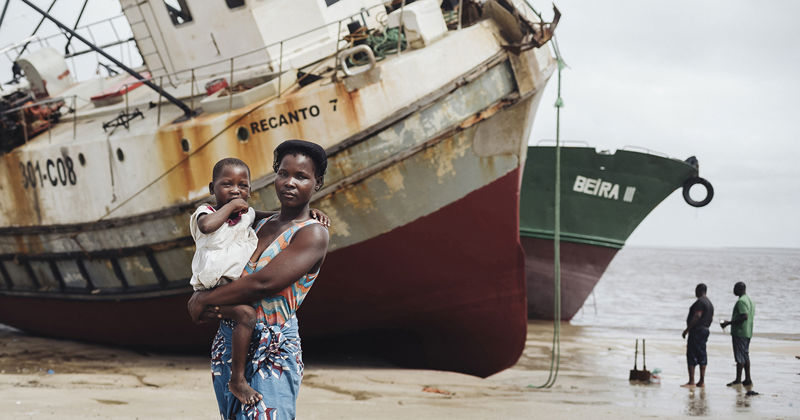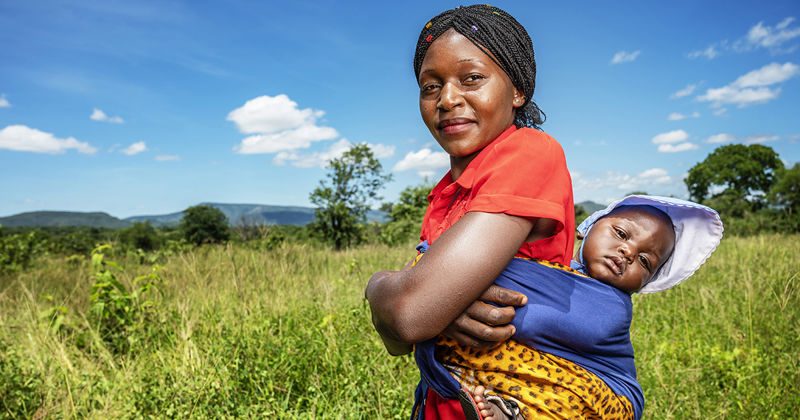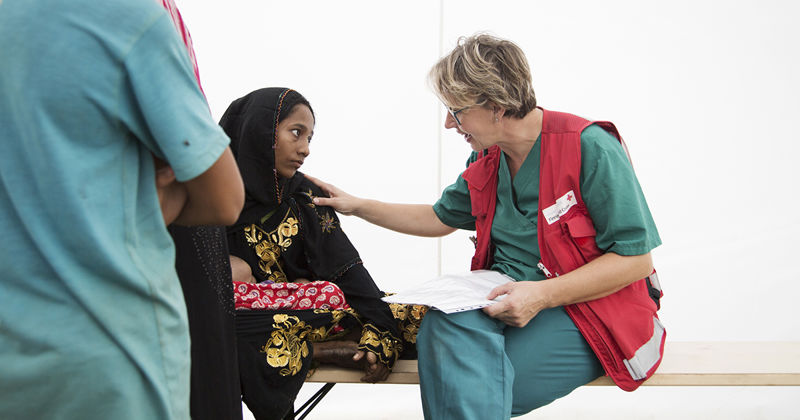
Emergency Response Units
The International Red Cross sends Emergency Response Units to help victims of natural disasters or conflicts if a local Red Cross or Red Crescent Society requests assistance, help is needed urgently and the Society’s own resources are insufficient.
The Emergency Response Units (ERUs) coordinated by the International Red Cross supplement the emergency aid provided by the country’s authorities and the local Red Cross or Red Crescent Society for approximately four months.
The units operate independently or as part of services offered by local authorities. Their operation is initiated by aid workers, together with local workers.
The ERUs are service combinations governed by shared international standards. The units include trained personnel and material. They provide services to aid recipients and support the international aid operation of the Red Cross.
The national Red Cross and Red Crescent Societies in different parts of the world maintain units that can specialise e.g. in health, logistics, IT and telecommunications, water and sanitation, aid distribution or staff accommodation.
Aid workers and material aid
The international aid workers of the Finnish Red Cross are trained professionals who have gained up-to-date skills through their personal careers. The international aid worker reserve includes around 1,000 professionals from different fields, around half of whom have completed ERU training.
In the event of a disaster, the members of the reserve receive a text message alert allowing them to indicate their availability. The staff members are selected based on the assignment and the requirements of the unit to be sent out and deployed for 4–8 weeks at a time.
At its shortest, the time between the alert and personnel deployment has been mere hours. This is made possible by procedures negotiated with employers in advance.
Whenever possible, a large number of ERU workers are recruited from the disaster area.
Local workers and volunteers know the circumstances and culture of their area better than anyone and can speak the local languages. At the same time, the local people will learn to use the devices and equipment of the ERU, which will be handed over to the local Red Cross or Red Crescent or the authorities of the country at the end of the operation. This will strengthen the local ability to respond to future disasters.
ERUs are maintained by the Logistics Centre
The Emergency Response Units are constantly kept ready to deploy at the Finnish Red Cross Logistics Centre in Tampere. The Centre is also responsible for the materials of the units. Materials are acquired by using funds donated to the Disaster Relief Fund, for example.
The Finnish Red Cross will bear the costs of an Emergency Response Unit it has sent out for at least four months. If necessary, the unit operating times can also be extended.
To replace a unit donated to a disaster area, the Finnish Red Cross puts together a new unit to be ready for the next disaster.
Get to know the Finnish Red Cross ERUs
A Finnish Red Cross health centre is sent to a disaster area if it lacks primary health care services either partially or completely. Disaster areas can receive either fixed or mobile health centres.
A health centre is accompanied by around 10–15 aid workers, and local staff are also recruited for various tasks.
A health centre manages first aid, prevention and treatment of infectious and any tropical diseases, child health services, pregnancies and childbirth and health advice. If necessary, the health centre can also provide vaccinations and assessments of the local population’s state of health and nutrition.
A health centre can also be modified to respond solely to epidemics, such as cholera.
A fixed health centre can serve an area with a population of around 20,000–30,000 people. It can care for 50–200 patients in a 24-hour period. The health centres also have hospital beds.
A mobile health centre typically operates in a sparsely populated area with a population of around 10,000–20,000 people. There are no hospital beds at a mobile health centre.
A mobile health centre adapts to the local conditions and can equip between one and three units to circulate around the operating area, offering primary health care, advice and preventative care.
If necessary, patients are sent from a health centre for further treatment in a hospital.
You can find more information about mobile health centres here and fixed health centres here.
Finnish Red Cross field hospitals are sent to disaster areas that have insufficient hospital services available due to them having been destroyed in an earthquake, for example.
Around 35–45 aid workers travel with the unit. Additionally, local staff are hired for various roles.
In addition to primary health care, a field hospital provides specialised medical care services.
It has 24/7 wards for surgery and traumatology, internal diseases, infectious diseases and children’s diseases, as well as tropical diseases, where necessary. Furthermore, it provides gynaecology and maternity care services, including a labour ward. A hospital’s auxiliary services include an operating theatre, a laboratory and X-ray services, physiotherapy and psychosocial support services.
A hospital supports local health centres and is able to serve an area with a population of around 200,000–300,000 people. Each hospital is able to care for 150–250 patients in a 24-hour period and may have up to 100 hospital beds.
These hospitals can be modified according to the requirements, focusing for example on surgery.
You can find more information about field hospitals here.
An Emergency Response Unit dealing with logistics facilitates a fast and safe delivery of aid supplies to the recipients in a disaster area.
The unit consists of 4–7 professionals of various logistics sectors who, after having received the alert, will travel to a disaster area to coordinate the reception and delivery chain of the International Red Cross aid supplies.
Logisticians take care of the import, storage and transport of aid supplies to and in a disaster area.
The unit is either placed directly in a disaster area or some other location suitable for the transport requirements, such as a harbour or an airport. The logistics unit is a vital part of an aid distribution chain.
Local staff are also hired to assist logistics, depending on the circumstances. The Finnish Red Cross logisticians cooperate with the logisticians of a local Red Cross or Red Crescent, or the International Red Cross.
- Staff: team leader and delegates responsible for supply chain management, flight operation/logistics and storage/transport.
- The logistics unit will try to move as quickly and lightly as possible, and the unit and its equipment will primarily travel to the destination on a scheduled commercial flight. If all local infrastructure has been destroyed as a result of the disaster, the logistics unit can exceptionally be accompanied by tents, vehicles and a forklift, in which case the size of the unit is 80 cubic metres and its weight 10,000 kilograms.
You can find more information about the logistics unit here.
The Finnish Red Cross Emergency Response Unit that focuses on IT and telecommunications supports aid operations by ensuring functioning IT services and telecommunications connections. The unit consists of 2–4 IT and telecommunications professionals.
During disasters, telecommunications connections tend to become overburdened, and in a worst case scenario the whole system can collapse. Telecommunications are vital for the efficient delivery and coordination of aid.
The unit provides an aid operation with a telecommunications network with local services, which include file sharing, printing and scanning of documents.
An internet connection is created through the most cost-efficient means possible by using local service providers, mobile networks or satellite connections. If required, a local radio network can also be built for phone connections.
A telecommunications unit hires local staff and works with the local authorities, telecommunications professionals and the Red Cross or Red Crescent employees, depending on the circumstances.
- Staff: head of unit, computer and network specialist and radio network specialist
- Weight: the IT and telecommunications unit weighs around 1,600 kilograms and takes up around six cubic metres of transport space. It can be transported to its intended location on a scheduled commercial flight as needed.
You can find more information about the IT and telecommunications unit here.

Humanitarian aid

Development cooperation

Donate to the Disaster Relief Fund
